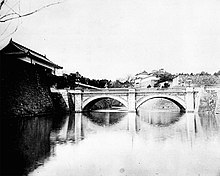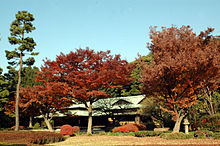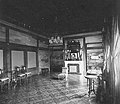The National Art Center Tokyo to Imperial Palace Miles
| Tokyo Imperial Palace | |
|---|---|
 Seimon Ishibashi span, which leads to the principal gate of the Imperial Palace | |
| Tokyo Imperial Palace | |
| Former names | Edo Castle |
| Full general information | |
| Classification | Royal Palace, the Majestic Household Agency, Three Palace Sanctuaries such equally the imperial family housing surface area of related facilities |
| Accost | 1-1 Chiyoda, Chiyoda-ku 100-0001 Tokyo |
| Town or metropolis | Tokyo |
| Country | |
| Coordinates | 35°40′57″N 139°45′08″Eastward / 35.6825°N 139.7521°E / 35.6825; 139.7521 Coordinates: 35°40′57″Due north 139°45′08″E / 35.6825°N 139.7521°Eastward / 35.6825; 139.7521 |
| Grounds | Circa 1.15 square kilometres (0.44 sq mi) (Imperial Household Bureau management part)[1] Circa ii.30 square kilometres (0.89 sq mi) (total area (including Kokyo Gaien National Garden)) |
The Tokyo Imperial Palace ( 皇居 , Kōkyo , literally 'Imperial Residence') is the chief residence of the Emperor of Japan. It is a big park-like area located in the Chiyoda district of the Chiyoda ward of Tokyo and contains several buildings including the Fukiage Palace ( 吹上御所 , Fukiage gosho ) where the Emperor has his living quarters, the main palace ( 宮殿 , Kyūden ) where various ceremonies and receptions accept place, some residences of the Imperial Family, an annal, museums and administrative offices.
It is built on the site of the one-time Edo Castle. The full area including the gardens is 1.fifteen square kilometres (0.44 sq mi).[1] During the superlative of the 1980s Japanese holding chimera, the palace grounds were valued by some to exist more than the value of all of the real estate in the U.S. land of California.[2] [3] [4]
History [edit]
Edo castle [edit]

The Kyūden shortly after its completion in the late 1800s

Kenanfu, Tokyo Imperial Palace
Later on the capitulation of the shogunate and the Meiji Restoration, the inhabitants, including the Shōgun Tokugawa Yoshinobu, were required to vacate the bounds of the Edo Castle. Leaving the Kyoto Regal Palace on 26 November 1868, the Emperor arrived at the Edo Castle, made information technology to his new residence and renamed it to Tōkei Castle ( 東京城 , Tōkei-jō ). At this fourth dimension, Tōkyō had also been chosen Tōkei. He left for Kyōto once again, and later on coming dorsum on nine May 1869, it was renamed to Regal Castle ( 皇城 , Kōjō ).[5]
Previous fires had destroyed the Honmaru surface area containing the old donjon (which itself burned in the 1657 Meireki fire). On the night of 5 May 1873, a fire consumed the Nishinomaru Palace (formerly the shōgun's residence), and the new imperial Palace Castle ( 宮城 , Kyūjō ) was constructed on the site in 1888. The castle has many gardens.

June, 1902. Tokyo Imperial Palace

Regal Palace in Tokyo 1908[six]
A non-profit "Rebuilding Edo-jo Association" ( NPO法人 江戸城再建 ) was founded in 2004 with the aim of a historically right reconstruction of at least the principal donjon. In March 2013, Naotaka Kotake, caput of the grouping, said that "the capital letter city needs a symbolic building", and that the group planned to collect donations and signatures on a petition in back up of rebuilding the tower. A reconstruction blueprint had been made based on old documents. The Imperial Household Agency at the time had not indicated whether it would support the project.[7] [8]
The Erstwhile palace [edit]
In the Meiji period, most structures from the Edo Castle disappeared. Some were cleared to make manner for other buildings while others were destroyed by earthquakes and fire. For case, the wooden double bridges ( 二重橋 , Nijūbashi ) over the moat were replaced with rock and iron bridges. The buildings of the Regal Palace constructed in the Meiji era were constructed of woods. Their pattern employed traditional Japanese architecture in their exterior appearance while the interiors were an eclectic mixture of fashionable Japanese and European elements. The ceilings of the grand chambers were coffered with Japanese elements; notwithstanding, Western chairs, tables and heavy defunction furnished the spaces. The floors of the public rooms had parquets or carpets while the residential spaces used traditional tatami mats.
The main audience hall was the central office of the palace. It was the largest building in the compound. Guests were received there for public events. The flooring infinite was more than 223 tsubo or approximately 737.25 thousandtwo (seven,935.7 sq ft). In the interior, the coffered ceiling was traditional Japanese-style, while the floor was parquetry. The roof was styled similarly to the Kyoto Regal Palace, but was covered with (fireproof) copper plates rather than Japanese cypress shingles.
In the late Taishō and early Shōwa menses, more physical buildings were added, such every bit the headquarters of the Purple Household Ministry building and the Privy Council. These structures exhibited simply token Japanese elements.
From 1888 to 1948, the chemical compound was called Palace Castle ( 宮城 , Kyūjō ). On the nighttime of 25 May 1945, virtually structures of the Imperial Palace were destroyed in the Allied firebombing raid on Tokyo. According to the US bomber pilot Richard Lineberger, Emperor's Palace was the target of their special mission on July 29, 1945, and was hitting with 2000-pound bombs.[9] [10] In August 1945, in the closing days of World War II, Emperor Hirohito met with his Privy Council and fabricated decisions culminating in the give up of Nihon at an underground air-raid shelter on the palace grounds referred to as His Majesty's Library ( 御文庫附属室 , Obunko Fuzokushitsu ).[11]
Due to the large-scale destruction of the Meiji-era palace, a new master palace hall ( 宮殿 , Kyūden ) and residences were constructed on the western portion of the site in the 1960s. The area was renamed Regal Residence ( 皇居 , Kōkyo ) in 1948, while the eastern function was renamed East Garden ( 東御苑 , Higashi-Gyoen ) and became a public park in 1968.
Interior images of the sometime Meiji-era palace
-
Higashidamari-no-Ma
-
Chigusa-no-Ma
-
Hōmei-Den
-
Kiri-no-Ma
-
Nishidamari-no-Ma
-
Throne hall
Nowadays palace [edit]

Map of the Imperial Palace and surrounding gardens
The present Imperial Palace encompasses the retrenchments of the former Edo Castle. The modern Kyūden ( 宮殿 ) designed for diverse imperial courtroom functions and receptions is located in the old Nishinomaru section of the palace grounds. On a much more modest calibration, the Fukiage Palace ( 吹上御所 , Fukiage gosho ), the official residence of the Emperor and empress, is located in the Fukiage Garden. Designed by Japanese architect Shōzō Uchii the modern residence was completed in 1993.[12] This residence is currently (July 2020) non in use and beingness prepared for Naruhito, who for the fourth dimension beingness keeps his primary residence at the old Tōgū Palace, renamed Akasaka Palace ( 赤坂御所 , Akasaka gosho ) while he resides at that place.
Except for the Regal Household Agency and the Eastward Gardens, the main grounds of the palace are generally closed to the public, except for reserved guided tours from Tuesdays to Saturdays (which admission only the Kyūden Totei Plaza in front of the Chowaden). Each New year's day (January two) and Emperor's Birthday, the public is permitted to enter through the Nakamon (inner gate) where they gather in the Kyūden Totei Plaza. The Imperial Family appears on the balcony earlier the oversupply and the Emperor normally gives a brusk speech greeting and thanking the visitors and wishing them expert health and blessings. Parts of the Fukiage garden are sometimes open to the general public.
The old Honmaru, Ninomaru, and Sannomaru compounds at present comprise the East Gardens, an area with public access containing administrative and other public buildings.
The Kitanomaru Park is located to the northward and is the former northern enceinte of Edo Castle. It is a public park and is the site of the Japan Budokan. To the south is Kokyo Gaien National Garden.
Though much of the site is off limits to the public, there have been multiple instances of tourists attempting to trespass on the palace grounds by swimming in the moat. In 2008, a British tourist stripped naked, repeatedly dove into and swam beyond the moat in an attempt to avoid being arrested, and used stones and a plastic pole as weapons when faced by staff and local constabulary officers.[xiii] A similar incident took place in 2013, in which two drunken tourists decided to try to sneak into the palace edifice after removing their clothing and entering the water near Sakurada Gate.[14]
Grounds [edit]
Kyūden [edit]



The Imperial Palace ( 宮殿 , Kyūden ) and the headquarters of the Regal Household Agency are located in the former Nishinomaru enceinte (W Citadel) of the Edo Castle.[15]
The main buildings of the palace grounds, including the Kyūden ( 宮殿 ) main palace, home of the liaison conference of the Royal General Headquarters, were severely damaged by the fire of May 1945. Today'southward palace consists of multiple mod structures that are interconnected. The palace complex was finished in 1968 and was constructed of steel-framed reinforced concrete structures produced domestically, with two stories above ground and 1 story below. The buildings of the Imperial Palace were constructed past the Takenaka Corporation in a modernist mode with clear Japanese architectural references such as the large, gabled hipped roof, columns and beams.
The complex consists of vi wings, including:
- Seiden Country Function Hall
- Hōmeiden State Banquet Hall
- Chōwaden Reception Hall
- Rensui Dining Room
- Chigusa Chidori Drawing Room and
- The Emperor's work office
Halls include the Minami-Damari, Nami-no-Ma, multiple corridors, Kita-Damari, Shakkyō-no-Ma, Shunju-no-Ma, Seiden-Sugitoe (Kaede), Seiden-Sugitoe (Sakura), Accept-no-Ma, Ume-no-Ma and Matsu-no-Ma.[16] Famous Nihonga artists such as Maeda Seison were commissioned to paint the artworks.
The Kyūden is used for both receiving state guests and holding official state ceremonies and functions. The Matsu-no-Ma (Pine Sleeping accommodation) is the throne room. The Emperor gives audiences to the Prime number Minister in this room, besides as appointing or dismissing ambassadors and Ministers of Land. It is also the room where the Prime Minister and Chief Justice is appointed to office.

Fukiage Garden [edit]
The Fukiage Garden has carried the name since the Edo menstruation and is used equally the residential area for the Imperial Family unit.
The Fukiage Palace ( 吹上御所 , Fukiage gosho ), achieved in 1993, was used every bit the chief residence of Akihito from December eight, 1993 to March 2020. Later on a menstruum of refurbishment, Naruhito, Masako and Aiko moved in in September 2021.
The Fukiage Ōmiya Palace ( 吹上大宮御所 , Fukiage Ōmiya-gosho ) in the northern section was originally the residence of Emperor Showa and Empress Kōjun and was chosen the Fukiage Palace. Later on the Emperor's death in 1989, the palace was renamed the Fukiage Ōmiya Palace and was the residence of the Empress Dowager until her death in 2000.[17] Information technology is currently non in use.
The palace precincts include the Iii Palace Sanctuaries ( 宮中三殿 , Kyūchū-sanden ). Parts of the Imperial Regalia of Nippon are kept here and the sanctuary plays a religious role in majestic enthronements and weddings.
East Gardens [edit]
The East Gardens is where well-nigh of the authoritative buildings for the palace are located and encompasses the one-time Honmaru and Ninomaru areas of Edo Castle, a total of 210,000 1000ii (2,300,000 sq ft). Located on the grounds of the East Gardens is the Regal Tokagakudo Music Hall, the Music Department of the Board of Ceremonies of the Regal Household, the Archives and Mausolea Department Purple Household Agency, structures for the guards such as the Saineikan dojo, and the Museum of the Imperial Collections.
Several structures that were added since the Meiji menstruum were removed over time to allow construction of the East Garden. In 1932, the kuretake-ryō was built equally a dormitory for imperial princesses, however this building was removed prior to the construction of the present gardens. Other buildings such as stables and housing were removed to create the East Garden in its present configuration.
Construction work began in 1961 with a new pond in the Ninomaru, too as the repair and restoration of various keeps and structures from the Edo period. On 30 May 1963, the area was alleged by the Japanese government a "Special Historic Relic" under the Cultural Backdrop Protection Law.
Tōkagakudō (Music Hall) [edit]

The Tōkagakudō ( 桃華楽堂 , Peach Blossom Music Hall) is located to the east of the former main donjon of Edo Castle in the Honmaru. This music hall was built in commemoration of the 60th altogether of Empress Kōjun on half-dozen March 1963. The ferro-concrete building covers a total area of 1,254 thousand2 (xiii,500 sq ft). The hall is octagon-shaped and each of its viii outer walls is busy with differently designed mosaic tiles. Structure began in Baronial 1964 and was completed in February 1966.
Ninomaru Garden [edit]
Symbolic copse representing each prefecture in Nippon are planted in the northwestern corner of Ninomaru enceinte. Such copse take been donated from each prefecture and in that location are total of 260, covering xxx varieties.
The pocket-sized Ninomaru Garden at the foot of the castle colina was originally planted in 1636 by Kobori Enshu, a famed landscape artist and garden designer, but it was destroyed past fire in 1867. The current layout was created in 1968, based on a programme drawn up during the reign of ninth shogun, Tokugawa Ieshige.[18]

Suwa no Chaya [edit]
The Suwa no Chaya ( 諏訪の茶屋 ) is a teahouse that was located in the Fukiage Garden during the Edo period. It moved to the Akasaka Palace afterwards the Meiji restoration, but was reconstructed in its original location in 1912.
It was moved to its present location during the construction of the Eastward Garden.
Kitanomaru [edit]
The Kitanomaru Park is located to the n and is the former northern enceinte of Edo Castle. Information technology is a public park and is the site of Nippon Budokan Hall.
This garden contains a bronze monument to Prince Kitashirakawa Yoshihisa ( 北白川宮能久親王 , Kitashirakawa-no-miya Yoshihisa-shinnō ).
Kōkyo-gaien [edit]
To the south-east are the large outer gardens of the Imperial Palace, which are also a public park and contain bronze monuments to Kusunoki Masashige ( 楠木正成 ) and to Wake no Kiyomaro ( 和気清麻呂 ).
Gallery [edit]
-
View of the Purple Palace and the Royal Household Bureau.
-

Ote-mon gate and main entrance to the "East Garden"
-

Imperial Palace moat and guard belfry
-

Regal Palace front entrance field with Chiyoda office buildings in the background
-

Suwa no chaya teahouse in the Ninomaru Garden
-
Saineikan dōjō for the guards
-
Building of the onetime Privy Quango in the East Garden surface area, one of the few buildings from the pre-war Showa period
-
New ambassadors arrive at the palace to hand in their accreditation to the Emperor to be picked up from Tokyo Station either in a limousine or the wagon.[ commendation needed ]
-
Music Section of the Board of Ceremonies
-

Museum of the Imperial Collections
-

Archives and Mausolea Department
-
The moat of the Imperial Palace in spring
-

Public walkway, Edo East Garden
-
Moat of the Imperial Palace
-

One of the entrances for supporting staff buildings
-

Fujimi-yagura (Mt Fuji-view keep), guard building within the inner grounds of the Purple Palace
-

Pond in the Due east Garden at the Imperial Palace
-

Mounted Imperial Police around the Imperial Palace
References [edit]
- ^ a b "皇居へ行ってみよう". Kunai-chō. Retrieved 2018-01-02 .
- ^ Mueller, Dennis C. (2012). The Oxford Handbook of Commercialism. Oxford University Press. p. 497. ISBN9780199942596 . Retrieved 2 May 2019.
- ^ Ian Cowie (7 August 2004). "Oriental risks and rewards for optimistic occidentals". The Daily Telegraph. Archived from the original on 2022-01-12. Retrieved 2013-05-07 .
- ^ Edward Jay Epstein (17 February 2009). "What Was Lost (and Constitute) in Japan's Lost Decade". Vanity Fair. VF Daily. Retrieved 2011-09-02 .
- ^ 皇居 ‐ 通信用語の基礎知識. Wdic.org (in Japanese). 2010-02-04. Retrieved 2015-09-fourteen .
- ^ Tom (2015-09-27). "Lovely 1908 Photograph of the Tokyo Majestic Palace". Absurd Old Photos . Retrieved 2019-03-03 .
- ^ "Rebuilding "Edo-jo" Clan". Retrieved 2008-09-17 .
- ^ Daily Yomiuri NPO wants to restore Edo Castle glory March 21, 2013
- ^ Richard C. L., Lineberger, "The Night We Bombed the Emperor's Palace," Air Ability History, fifty/3, (September 22, 2003) : 42 pages.
- ^ The Costless Library past Farlex, https://www.thefreelibrary.com/The+night+we+bombed+the+Emperor%27s+Palace-a0108551529
- ^ "Time Wears on Imperial Shelter". The Japan News. Yomiuri Shimbun. 1 August 2015. Retrieved i August 2015.
- ^ "The Imperial Residence". The Majestic Household Bureau . Retrieved 22 August 2015.
- ^ Reuters Staff (2008-10-08). "Naked swimmer evades law in Tokyo palace moat". Reuters . Retrieved 2021-03-25 .
- ^ "Drunk Brits swim to palace, arrested". The Japan Times. 2013-04-16. Retrieved 2021-03-25 .
- ^ Takahiro Fukada (20 January 2010). "Imperial Palace resides in otherworldly expanse: History abounds in cultural and religious preserve in heart of metropolis". The Japan Times. p. iii.
- ^ "The Imperial Palace: Photos". kunaicho.become.jp. Royal Household Bureau. Retrieved 2015-09-14 .
- ^ "The Imperial Palace and other Royal Household Establishments". Majestic Household Agency. Archived from the original on February 12, 2008. Retrieved 16 October 2008.
- ^ "Ninomaru and San-nomaru - Tokyo Cultural Heritage Map". Tokyo Cultural Heritage Map, Tokyo Metropolitan Board of Instruction . Retrieved 19 June 2019.
External links [edit]
- Imperial Household Agency | Purple Palace in Tokyo
- Prototype gallery of the Royal Palace
- Regal Palace Map
- Information on visiting the Imperial Palace on the Emperor'south birthday
Source: https://en.wikipedia.org/wiki/Tokyo_Imperial_Palace














0 Response to "The National Art Center Tokyo to Imperial Palace Miles"
Enviar um comentário